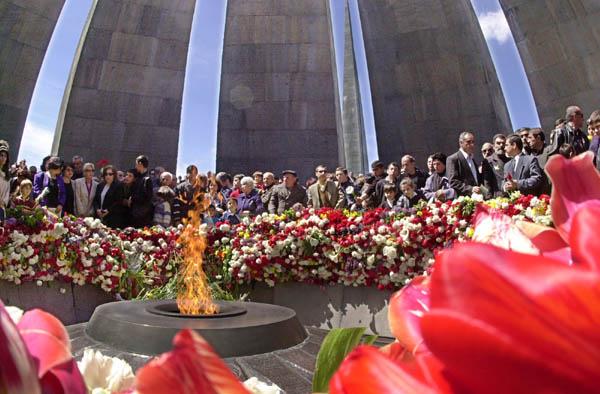
There is a day in year that Armenians remember with pain and sorrow. This is April 24. On that day thousands of people come to Armenia from different corners of world to pay homage to the victims of 1915. The mass massacres and exiles organized by the Ottoman Empire became a real enormity which cost the lives of 1.5 million Armenians. It was the most tragic event of the 20th century which shocked the whole civilized world. According to the beforehand planned program the Ottoman Government exiled the defenseless people from their lands to sentence them to deportation and starvation.
In 1965 the memorial monument Tsitsernakaberd was built in memory of the victims of the genocide, and it became an integral part of architecture of Yerevan becoming a sacred place. Being situated in a high mountainous place the memorial rises on a forested hill as an eternal witness of the atrocities against a whole nation. The monument includes 12 towering stones as the symbols of 12 evacuated provinces of Western Armenia with the Eternal fire burning in the middle; “Revival of Armenia” obelisk and the Museum devoted to the genocide – “The Temple of Eternity” which opened its doors in 1995. The first floor of the museum is subterranean which includes the repository of scientific values, library and the hall after Komitas. The map of Armenian plateau is engraved on the wall of the first chamber, the second one presents the testimonies of witnesses and documents about the massacres.
There is also a gallery for temporary exhibitions of famous Armenian artist Jansem (H. Semerjyan). The last hall of the museum is an open-air yard which is unique for ancient Armenian buildings. The Armenian Genocide has been recognized by Uruguay, France, Germany, Argentina, The Netherlands, Slovakia, Canada, Switzerland, Italy, Lebanon, Sweden, Belgium, Greece, Cyprus, Russia, Poland, Lithuania, Venezuela, Chile, Australia and Vatican. Recently the French Parliament passed the bill criminalizing the denial of Genocide. The Government of RA, considering the fate of the coming generations, tries to find the borders of collaboration with the descendant of Ottoman Empire for which the president of RA accepted a decision to open the borders between Armenian and Turkey to improve the economic and political relations between our countries. But this process is stopped as the Turkish government refused to sign the agreement without any preconditions. There are other facts proving the Genocide together with the documents such as the films of Armenian and foreign directors: “La Masseria Della Allodole” by brothers Taviani, “Ararat” by Atom Egoyan, “Mayrig” by Henri Verneuil, and “Forty Days of Musa Dagh” by Sarki Muradyan. Now an American film by Gor Kirakosyan “Lost and Found in Armenia” is to be shot in Armenia.
This bilingual film which finds a balance between comedy and human emotion will be ready in 2012. World famous celebrities also struggle for the recognition of Armenian Genocide. The artists struggling for peace are Stevie Wonder, Michael Stone, Eric Benet, Alexia Vassiliou, Chaka Khan and Arto Tunjboyajyan who participated in the first concert of the concert program “Never Again” organized by popular artist of RA Flora Martirosyan in memory of the victims of Genocide in “Gibson” amphitheater of Los Angeles in 2011. This large project is aimed to make the whole world be aware of the vandalism of 1915 and call to challenge of hope and peace before the 100th anniversary of Armenian Genocide. However, the civilized world spare no effort to undertake any method so that the world community and especially the governments can recognize the indescribable tragedy of the 20th century which has only one supreme aim that is the of repetition of such a criminal act.










